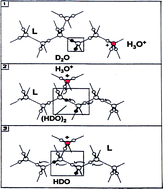Relating the current science of ion-defect behavior in ice to a plausible mechanism for directional charge transfer during ice particle collisions
Abstract
A melding of modern experimental results descriptive of fundamental ion defect properties of ice is presented as a logical basis of a mechanism for the preferential transfer of positive charge from large to small colliding ice particles. The result may relate to the electrification of storm clouds. It is broadly agreed that such localized charge transfer during collision of small upwardly mobile ice particles with falling ice granules (i.e., graupel/hail) can lead to macroscopic charge separation capable of initiating lightning strikes during the expansion stage of a storm cell. Though the larger particles are thought to become negatively charged during the collisions neither a generally favored charge-exchange agent nor a preferred mechanism for the directional particle-to-particle charge transfer exists. Nevertheless, should ionic point defects of ice play a key role, the fundamental properties of ice defects considered here must apply. They include: (1) above 140 K

- This article is part of the themed collection: Physics and chemistry of ice and water

 Please wait while we load your content...
Please wait while we load your content...